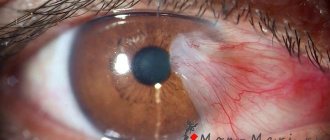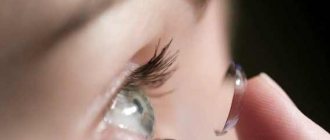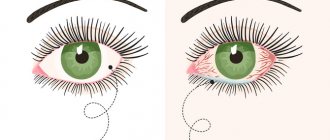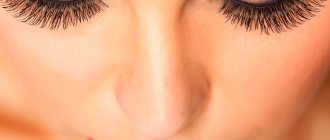Why might the lens break?
The polymer from which contact correction devices are made can be damaged due to several factors:
1. Inadequate quality of optics. This usually happens if the consumer purchases products from unverified manufacturers on the Internet, often these are colored lenses. In pursuit of dubious savings, we often harm our health. The difference between the products of certified global brands and those of an unknown company will be insignificant, but the problems can be global. The low price should immediately alert you. Please read reviews of these products before making a purchase.
2. Often the cause of damage to ophthalmic products can be their improper use. This also includes improper storage, failure to comply with replacement deadlines, violation of the wearing regime, errors in the process of putting on and taking off. When you start using contact optics, you should carefully study the rules for putting them on and taking them off, because this process will have to be carried out twice a day.
3. Drying out the lens in the eye can also lead to its rupture. This happens when it is not hydrated enough. If you have to spend a long time, for example, in a room with dry air, you should stock up on moisturizers.
4. Too sharp or unkempt nails can also cause contact correction devices to rupture. In this case, you should get your nails done regularly to prevent this from happening.
5. Expiration of lenses. Typically, the polymer becomes more brittle and prone to damage.
What to do if the lens breaks?
How can you tell if an optical product is damaged? Make it a rule every time before putting on contact lenses to carefully inspect them in the light, even if it is a new pair from a blister pack: no one is protected from manufacturing defects. If even a micro-tear is detected, they should not be used under any circumstances: in addition to a feeling of discomfort, this can lead to irritation of the mucous membrane and cornea, which will cause unpleasant consequences for eye health.
The damaged lens should be thrown away and replaced with a new one. If this was the last pair, then temporarily use glasses, which it doesn’t hurt to have on hand for emergency situations.
Why do lenses break? On the issue of quality
The main reason why lenses break is, of course, their poor quality or manufacturing defect. That is why we strongly recommend that you purchase only products from well-known brands that have proven themselves in the optics market.
In addition, the quality of contact lenses may be impaired during transportation, as well as due to violation of storage conditions. We often pay attention to an attractive price, lower than the market average.
However, we should not forget that these ophthalmic products come into direct contact with the eyes, and in no case should you skimp on their health.
The lens in the eye breaks - what to do?
It also happens that optical products can break while being in front of your eyes. What to do in this case? This often happens when lenses are removed or put on, or when they are not sufficiently moisturized and dry out in hot climates. How can you tell if contact correction devices have broken while being worn? Decreased visibility, a feeling of discomfort, or a sensation of a foreign body when blinking may indicate this. Carefully remove the lens and inspect it.
If the fears are confirmed, then there is some possibility that a few particles of the polymer remain in the eye and can cause inflammation. But don't panic. Nature is unusually wise and has designed our body in such a way that it is able to cleanse itself. This also applies to the organs of vision.
Try to determine where exactly the polymer particles could remain. You can do this by looking in the mirror, or you can determine it tactilely by feeling it with your fingers. As is correct, most often the particles get stuck under the upper eyelid. Pull it back and direct the light to give yourself a good view, or better yet, ask someone to help you do this. If they are visible, try to carefully remove them with thin tweezers, or apply moisturizing drops and blink vigorously to push the pieces out from under the eyelid. You can also lightly push them towards the inner edge of the eye, where they should come out.
The lens broke - why? Let's look at the main reasons
To avoid contact lens rupture, you need to know when this can happen.
Reason No1. Incorrect operation
A common problem for those who have only recently abandoned glasses in favor of contact lenses. It is necessary to remove the latter using pinching movements with your fingertips, without picking at all. Before doing this, it is important to wash your hands thoroughly with soap. If discomfort occurs, you should not rub your eyes - instead, carefully remove the lens and examine it for dirt or damage, check whether it is on the wrong side, then dip it in a fresh solution and put it on again. It is worth noting that the smaller
the product and the more moisture it contains, the thinner it will be
. Therefore, the more careful you need to handle it.
Reason No2. Incorrect lens geometry
If it moves and “dangles” when blinking, then most likely it has a larger diameter than required. If the dimensions of the lens are smaller than those of the eye, then it will “stick”. For this reason, it is important to have your visual acuity and eye tissue examined by an ophthalmologist before purchasing.
Reason No3. Various types of damage
The products described in the article are characterized by special sensitivity to sharp objects. Therefore, if you have long nails, then it is better to use special tweezers for manipulation. In addition, eyes should be protected in production that involves contaminated premises (this could be sawdust, dust, etc.), preferably with safety glasses.
Reason No4. Non-compliance with wearing regime
For example, you can wear regular annual lenses for no more than 8 hours at a time. After this time, the product dries out, the person begins to experience discomfort, redness and “sand” appear in the eyes. Then, when removed, the dry lens may stick together, and if you try to straighten it, it may even tear.
Note!
To avoid this problem, apply several moisturizing eye drops before removing the product. If the lens is stuck together, place it in a container with fresh water, wait a while and only then try to straighten it.
Table. Instructions for removing a stuck lens.
| Steps, photo | Description of actions |
| Wash your hands thoroughly first, otherwise you risk getting an infection. Try not to wipe your fingertips (with which you will remove the stuck product) with a towel, otherwise small fibers will get into your eyes. | |
| Don't panic - this will make it even more difficult to remove the optical product. You can pause and take a few deep breaths if you are very nervous. Contrary to popular belief, the lens cannot move behind the eye in any way, and does not pose a serious threat to health. | |
| Determine exactly where the lens is located. It’s not difficult to do this – just trust your feelings. As a last resort, you can feel it with your hands, after closing your eye. If none of the methods helped determine the location of the lens, then perhaps it simply fell out. | |
| Place a special solution in your eyes to moisten the lens (it may be stuck because it has dried out). Wait a little, blink a few times and try to get it out again. | |
| If the product is under the eyelid, then you need to close the eye and lightly massage it (the eyelid) with your fingers. Try moving it onto the cornea. | |
| If the lens “fits” correctly, but does not come off, try to remove it not by the traditional method, but by blinking and lightly pressing your finger on the eyelid. This should help. | |
| If the lens is under the eyelid, you need to lift it. You can use a cotton swab. You may also need help from friends or relatives. | |
| If the described methods are ineffective and severe irritation, consult an ophthalmologist. The specialist will be able to remove the lenses without injuring the eye. |
Note!
If you think you have damaged your lens while trying to remove it, visit your doctor as soon as possible! By the way, even if it is successfully removed, it is still better to consult a doctor to check whether the eye was damaged.
Reason No5. Expired products
If your lenses are past their expiration/replacement dates, they may become fragile. Moreover, over time, small scratches from dust appear on the surface, and deposits of organic origin accumulate.
Reason No6. Manufacturing defect, low quality
One of the most common reasons. That is why it is advisable to purchase lenses only from well-known and trusted manufacturers. At the same time, do not forget that the quality of products may be impaired during transportation or storage.
Important!
People are often “deceived” by the lower price, forgetting that the lenses come into direct contact with the eyes, and therefore cannot be saved on them.
How to prevent damage to optics
Doctors suggest taking measures to reduce the risk of lens damage.
Lens suction cup
This accessory is available in a set with ophthalmic products and is intended for care. You can use it if a person has long and sharp nails. It is easier to remove and put on lenses and there is no damage. Suction cups are sold separately in online stores or optical stores.
Storage solution
The liquid is used for moisturizing and cleaning.
If the lens is a little dry, you cannot straighten it or pull off the stuck edges. This method will cause damage. The solution is poured into a special container, the lenses are placed there for several hours, then straightened. Tweezers are used to extract fluid. The ophthalmic agent is examined and breaks are determined. Lenses dry out if stored incorrectly or expire.
Letters from our readers
Subject: I no longer need glasses and contacts! From: Christina( [email protected] )VKontakte: Christina Z.
To: Administrationproglazki.ru
Christina, Moscow
I have had vision problems since childhood; I wore glasses at school, but at university I switched to contact lenses.
I accidentally found an article on the Internet that gave me hope. They gave me a free consultation over the phone and answered all my questions and told me how to completely restore my vision in my case.
A week after starting the course of treatment, I began to notice that I could see worse with lenses than without them. I even began to perceive the pattern on the wallpaper in the room differently. Vision was restored, if not 100%, then definitely at least 80%. I'm sending a link to the article
Buying from trusted sellers
Only specialized branches with a license have the right to sell contact lenses. Other trading platforms may sell low-quality counterfeits. The difference between them is externally insignificant. Serious problems arise after use. Specialists know how to select ophthalmic products and work with online stores.
Therefore, you can order quality products without leaving your home. All necessary lens care products are on sale. The likelihood of buying counterfeit lenses is minimal. We offer a choice of products from well-known global manufacturers, for which users leave many reviews.
Compliance with terms of use
All contact lenses have an expiration date. It must be followed. The wearing regime is always observed, a container is used for storage, the solution is changed daily.
Symptoms
The first time people use contact lenses, they experience various discomforts. But lens misalignment is different from the standard feeling of dryness and “tiredness” in the eye. The following feelings indicate displacement of a contact lens:
- "eyewinker;
- itching;
- pain, burning;
- dryness;
- difficulty blinking;
- blurred vision.
Tearing and redness of the eye also indicate a problem.
If any discomfort occurs, you should check the position of the lens. If it is not on the cornea, remove it and put it on again.
What are the risks of wearing a “faulty” vision correction device?
If an eye contact lens becomes damaged, discard it immediately. Wearing a torn, cracked, scratched or dry lens can cause unpleasant consequences for the eyes:
- Lipid and protein deposits may remain in microcracks on the lens, and even after cleaning with a solution they will not be completely eliminated.
- Cracks and tears will lead not only to the correction product sliding off the cornea, but also to microscratches on its surface and, as a result, redness, burning, stinging in the eyes and other unpleasant sensations.
- Having been on the ground, the lens collected a lot of microbes and bacteria with dust, the contact of which on the surface of the eyeball is extremely undesirable - it can lead to the development of inflammatory processes such as conjunctivitis and barley, or even more serious consequences.
Take care of the things that help you see better throughout the day. But if the lens still “goes bad,” don’t put it on your eyes: it’s better to pay for a new one than to pay later for neglecting the banal rules of hygiene and using vision-correcting devices.
Why you shouldn't wear a damaged lens
At the rupture site, the lens has uneven edges that “cling” to the eyelids and injure the cornea. Wearing such an SCL causes a lot of suffering.
Moreover, a torn lens damages the epithelial cells of the cornea, which leads to the appearance of ulcers and even the development of keratitis. All this can result in the formation of a cataract and an irreversible drop in visual acuity.
If your health is important to you, don’t try to save money. Believe me, buying a new product will cost less than treating dangerous complications.
How to get the lens
Removing a contact lens is a simple process that requires some experience. If the lens is positioned correctly, removing it should not be difficult.
With clean hands
- If the lens is in place, then press on it with the index finger and “pull” it down, while the eye looks up;
- pull back the lower eyelid, “pinch” the lens towards the center and squeeze it;
- removed from the eye, washed and placed in a special container filled with solution.
If the lens is not initially on the cornea, you need to start removing it immediately from the second point. With wearing experience, the need to move the lens around the eye will disappear and it will be possible to remove it directly from the cornea.
How to remove a lens if it is damaged
STEP 1: Find a well-lit area and take a mirror. STEP 2: Wash your hands thoroughly with soap and dry them with a towel or cloth that will not leave lint on your hands. STEP 3: If you have it with you, place a few drops in the eye with the torn lens. If you don't have eye drops with your lenses, use a few drops of an all-purpose cleaning solution (if it's allowed to be applied directly to your eyes), if not, use a couple drops of saline or even clean filtered water to wet your lenses. Wet lenses are much easier to obtain than dry lenses.
STEP 4: Pull your lower eyelid down and use your free finger to push the torn lens down towards the white part of your eye. STEP 5: Using your thumb and index finger, pinch the lens between them. It will bend a little and you can remove it from the eye. STEP 6: Take a good look at the torn lens. Check if you got it all. If this is not the case, then some parts of the lens are still in the eye.
STEP 7: To check the eye for the presence of torn parts of the lens: first, with your thumb and middle finger, pull up and hold the upper eyelid in this position, looking as down as possible. When doing this, any remaining pieces should slide towards the center of the eye. You can get these missing fragments using a moistened finger. Repeat step 7 until you are confident that you have removed all of the broken lens pieces from your eye.
The information on our website is provided for informational purposes only and should not be used as an experiment without the advice of an ophthalmologist or other medical expert. We do not accept any responsibility for your actions taken without the approval of your ophthalmologist.
A torn contact lens should be thrown away immediately. Even if a small piece has come off on the side, the lens looks quite decent, and you feel like you can still walk around in it. It is dangerous to wear it! It makes no difference: the SCL is torn in half or its edge is just slightly torn - throw it away without any doubt.









